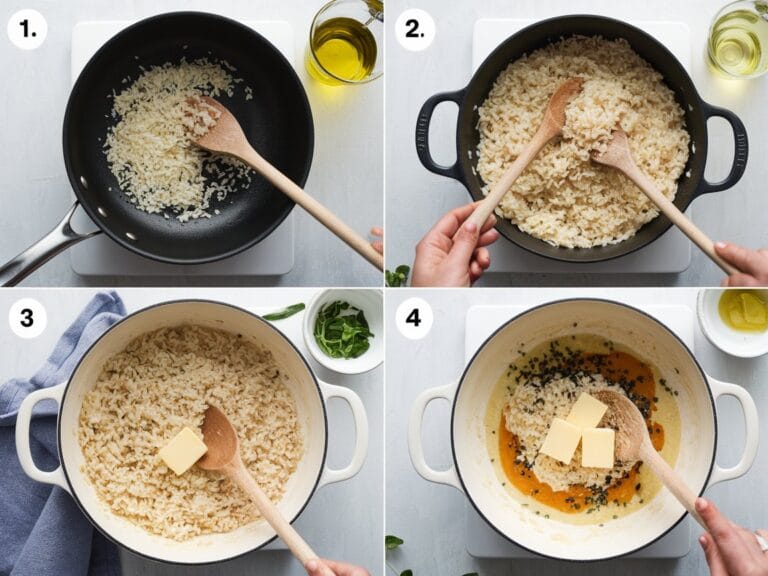Risotto is a beloved Italian dish famous for its creamy texture and rich flavors. While it may seem complex, achieving the perfect risotto comes down to understanding its four key stages. By following these stages carefully, you can create a risotto that’s smooth, flavorful, and perfectly cooked. In this article, we’ll break down the four stages of cooking risotto and offer expert tips to help you master each one.
For a deeper dive into risotto techniques, check out these risotto tips and techniques, which cover everything from ingredient preparation to cooking methods.
The 4 Stages of Cooking Risotto
1. Toasting the Rice
The first step in making risotto is toasting the rice in olive oil or butter. This step is essential because it enhances the rice’s flavor and ensures that the grains remain firm during cooking.
- Why is toasting important?
Toasting helps to create a protective barrier around each grain of rice, allowing it to absorb the liquid slowly and evenly. This technique also develops a subtle nutty flavor, which adds depth to the dish. Toasting is a technique used in many recipes, like in this Pumpkin Banana Loaf, where toasting enhances flavor early on.
Explore this perfect risotto guide, which offers additional tips on toasting and seasoning.
2. Gradual Addition of Stock
After toasting the rice, the next stage is the gradual addition of stock. This process is critical for creating the creamy texture that risotto is known for.
- How to do it right:
Start by adding warm stock, one ladle at a time. Allow the rice to absorb the liquid before adding more. This method helps the rice release its starch, which is what makes risotto so creamy. Gradually incorporating liquids is a crucial technique, as seen in this Beef Stroganoff Without Mushrooms recipe, which helps achieve a smooth texture.
3. Stirring and Agitation
Stirring is one of the most important parts of making risotto. It helps release the starch from the rice, which thickens the dish and gives it its signature creaminess.
- How much stirring is necessary?
Stirring frequently is key, but avoid over-stirring, which can make the risotto gluey. Stir enough to keep the rice from sticking to the pan and to ensure that the starch is evenly distributed throughout the dish.
4. Mantecatura
Mantecatura is the final stage of making risotto, and it’s where the magic happens. This Italian term refers to the process of adding cold butter and Parmesan cheese to the risotto after it has been removed from the heat.
- Why is this step important?
This technique emulsifies the risotto, creating a luxurious, creamy texture that’s smooth and rich. Much like adding butter to desserts, such as in The Pioneer Woman’s Ultimate Hello Brownie Recipe, adding butter in this final stage ensures a rich, velvety finish.
Common Mistakes to Avoid
Overcooking the Rice
One of the most common mistakes when cooking risotto is overcooking the rice. Risotto should be cooked al dente, meaning the grains should be tender but still have a slight bite to them. Overcooking results in a mushy consistency, which ruins the dish’s texture.
Using Cold Stock
Using cold stock can disrupt the cooking process by causing the rice to cook unevenly. Always use warm stock to maintain a smooth and steady cooking process, ensuring that the rice absorbs the liquid properly.
Conclusion: Mastering the 4 Stages of Cooking Risotto
Mastering the four stages of cooking risotto toasting the rice, adding stock gradually, stirring properly, and mantecatura is the key to making a delicious, restaurant-quality risotto at home. By following these steps, you’ll achieve a dish that’s rich, creamy, and full of flavor.
For more cooking inspiration and tips, explore additional recipes and techniques on Recipes Alyssa to elevate your cooking game!
Print
What are the 4 stages of cooking risotto?
Risotto is a beloved Italian dish famous for its creamy texture and rich flavors. While it may seem complex, achieving the perfect risotto comes down to understanding its four key stages. By following these stages carefully, you can create a risotto that’s smooth, flavorful, and perfectly cooked. In this article, we’ll break down the four stages of cooking risotto and offer expert tips to help you master each one.
- Total Time: 40 minute
- Yield: 4 servings 1x
Ingredients
- 1 ½ cups Arborio or Carnaroli rice
- 4 cups chicken or vegetable stock (warmed)
- 1 small onion, finely chopped
- 2 cloves garlic, minced
- ½ cup dry white wine (optional)
- 2 tablespoons olive oil
- 2 tablespoons unsalted butter (plus extra for finishing)
- ½ cup freshly grated Parmesan cheese
- Salt and pepper to taste
- Fresh parsley or basil (optional, for garnish)
- 1 teaspoon lemon zest (optional)
Instructions
- Toast the Rice
- Heat olive oil and 2 tablespoons of butter in a large pan over medium heat.
- Add chopped onion and garlic, cooking until softened (about 3 minutes).
- Add Arborio or Carnaroli rice to the pan and toast for 2-3 minutes until slightly translucent, stirring constantly.
- Deglaze with Wine (Optional)
- Pour in white wine and stir until the liquid is absorbed, about 1-2 minutes.
- Gradually Add Stock
- Add warm stock, one ladle at a time, stirring frequently. Allow each addition of stock to absorb before adding the next. Continue until the rice is al dente and creamy (18-20 minutes).
- Finish with Butter and Parmesan (Mantecatura)
- Remove from heat and stir in additional butter and Parmesan cheese. This step will emulsify the risotto and give it a rich, creamy texture.
- Season with salt, pepper, and lemon zest if desired. Garnish with fresh herbs.
- Prep Time: 10 minutes
- Cook Time: 30-35 minutes
- Category: Main Course
- Method: Stovetop
- Cuisine: Italian
- Diet: Vegetarian
Keywords: risotto recipe, creamy risotto, perfect risotto, Arborio rice, Carnaroli rice, Italian risotto, step-by-step risotto, mantecatura, Parmesan risotto, how to cook risotto




